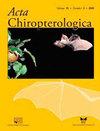Cytogenetic Analyses Detect Cryptic Diversity in Megaderma spasma from Malaysia
IF 0.7
4区 生物学
Q4 ZOOLOGY
引用次数: 3
Abstract
As many as 17 subspecies are currently recognized for the lesser false vampire, Megaderma spasma along its wide distributional range, from India to Southeast Asia. Cytogenetic studies have been so far restricted to specimens from only four geographical regions, namely Malaysia, Thailand, China and the Philippines. We examined the karyotypes of M. spasma medium from Peninsular Malaysia and M. s. trifolium from Malaysian Borneo with conventional and molecular cytogenetic techniques, using whole chromosome painting probes from the vespertilionid Myotis myotis and the hipposiderid Aselliscus stoliczkanus. Both Megaderma subspecies showed the same diploid chromosome number, 2n = 38, but differed concerning interstitial heterochromatic segments and number and shape of heterochromatic B chromosomes. Comparison with published data revealed that the Bornean specimens' karyotype best resembled the chromosomal set of the Chinese specimen. In contrast, a single male specimen from Malaysian Borneo showed a different karyotype (2n = 40) without B chromosomes and interstitial heterochromatin, indicating that it may represent a cryptic, yet unknown Megaderma species.细胞遗传学分析检测马来西亚痉挛性巨皮病的隐性多样性
目前,从印度到东南亚,有多达17个亚种被认为是较小的假吸血鬼,即痉挛性巨皮病。到目前为止,细胞遗传学研究仅限于来自四个地理区域的标本,即马来西亚、泰国、中国和菲律宾。我们用常规和分子细胞遗传学技术检测了来自马来西亚半岛的M.spacta培养基和来自马来西亚婆罗洲的M.s.trifolium的核型,使用了来自血管性肌炎和海马体Aselliscus stoliczkans的全染色体绘制探针。两个Megaderma亚种均表现出相同的二倍体染色体数目,2n=38,但在间质异色片段和异色B染色体的数目和形状方面存在差异。与已发表的数据相比,婆罗洲标本的核型与中国标本的染色体组最为相似。相反,来自马来西亚婆罗洲的一个雄性标本显示出不同的核型(2n=40),没有B染色体和间质异染色质,这表明它可能代表了一个神秘但未知的巨皮虫物种。
本文章由计算机程序翻译,如有差异,请以英文原文为准。
求助全文
约1分钟内获得全文
求助全文
来源期刊

Acta Chiropterologica
生物-动物学
CiteScore
2.50
自引率
20.00%
发文量
42
审稿时长
>12 weeks
期刊介绍:
Acta Chiropterologica, published by the Museum and Institute of Zoology at the Polish Academy of Sciences, is devoted solely to the study and discussion of bats.
 求助内容:
求助内容: 应助结果提醒方式:
应助结果提醒方式:


